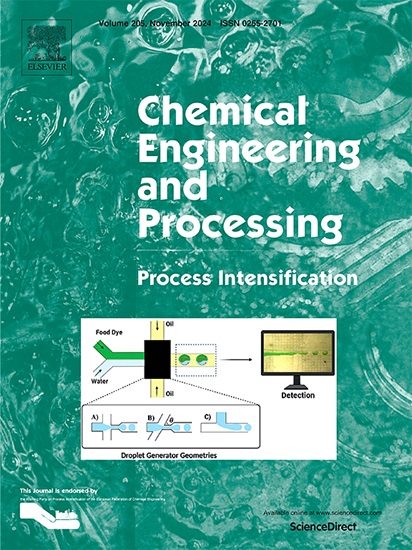An in-situ strategy of modified biochar–activated persulfate for low-temperature livestock wastewater treatment: Dynamic reaction kinetics and computational fluid dynamics-based multi-unit structure reactor design
IF 3.8
3区 工程技术
Q3 ENERGY & FUELS
Chemical Engineering and Processing - Process Intensification
Pub Date : 2025-06-15
DOI:10.1016/j.cep.2025.110412
引用次数: 0
Abstract
Livestock wastewater treatment in cold regions is hampered by low temperatures, small scale, and dispersed wastewater. Our research group previously synthesized δ-MnO2/biochar (BC) material for early-stage wastewater treatment, which has good low-temperature application prospects. Static experiments show that the critical temperature to ensure efficient composite pollution removal is 15 °C. Herein, δ-MnO2/BC/persulfate was adopted as the core technology, the key parameters of wastewater treatment were explored through large-capacity continuous dynamic experiments, and a unit internal circulation reactor was designed and optimized. The kinetic experiment showed that the overall removal rate of antibiotics could reach 65.27 % ∼ 72.57 % under the optimal reaction condition and 15 °C. The removal rate of trace heavy metal Cd could reach 100 %. Combined with fluent simulations via computational fluid dynamics modeling and technology verification, an industrial dynamic continuous unit reactor was designed with a volume of 40 m3. After optimization, the designed multiunit reactor effectively ensured an internal water temperature of >15 °C, stable operation at external temperatures from −25 °C to −20 °C, and could withstand an extremely low outside temperature of −35 °C. This research describes an effective industrial treatment strategy for livestock wastewater in cold regions and provides a practical application of advanced oxidation technology based on catalytic materials.

改性生物炭活化过硫酸盐原位处理低温牲畜废水的策略:动态反应动力学和基于计算流体动力学的多单元结构反应器设计
低温、规模小、废水分散等因素阻碍了寒区畜牧业废水的处理。课课组前期合成的δ-MnO2/生物炭(BC)材料用于废水早期处理,具有良好的低温应用前景。静态实验表明,确保复合材料有效去除污染的临界温度为15℃。本文以δ-MnO2/BC/过硫酸盐为核心工艺,通过大容量连续动态实验探索废水处理的关键参数,设计并优化了单元内循环反应器。动力学实验表明,在最佳反应条件和15℃条件下,抗菌药物的总去除率可达65.27% ~ 72.57%。对痕量重金属Cd的去除率可达100%。结合计算流体动力学建模和技术验证的流畅仿真,设计了容积为40 m3的工业动态连续单元反应器。优化后,设计的多单元反应器有效保证了内部水温为15°C,外部温度为- 25°C至- 20°C,外部温度为- 35°C,运行稳定。本研究描述了一种有效的工业处理寒区畜牧废水的策略,为基于催化材料的高级氧化技术提供了实际应用。
本文章由计算机程序翻译,如有差异,请以英文原文为准。
求助全文
约1分钟内获得全文
求助全文
来源期刊
CiteScore
7.80
自引率
9.30%
发文量
408
审稿时长
49 days
期刊介绍:
Chemical Engineering and Processing: Process Intensification is intended for practicing researchers in industry and academia, working in the field of Process Engineering and related to the subject of Process Intensification.Articles published in the Journal demonstrate how novel discoveries, developments and theories in the field of Process Engineering and in particular Process Intensification may be used for analysis and design of innovative equipment and processing methods with substantially improved sustainability, efficiency and environmental performance.

 求助内容:
求助内容: 应助结果提醒方式:
应助结果提醒方式:


